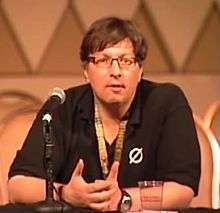Matt Blaze
| Matt Blaze | |
|---|---|
 Matt Blaze at DEF CON 20 in 2012 | |
| Residence | United States |
| Citizenship | American |
| Fields |
Computer security Distributed systems[1] |
| Institutions |
University of Pennsylvania[1] Bell Labs[2] |
| Alma mater |
Princeton University Columbia University Hunter College[1] |
| Known for |
Cryptography Trust management |
|
Website www | |
Matt Blaze is a researcher in the areas of secure systems, cryptography, and trust management. He is currently an Associate Professor of Computer and Information Science at the University of Pennsylvania, and on the board of directors of the Tor Project.[3]
Work
He received his PhD in Computer Science from Princeton University.
In 1992, while working for AT&T, Blaze implemented a strong cryptographic package known as "CFS", the Cryptographic File System, for Unix, since ported to Linux.[4] CFS uses Network File System as its transport mechanism, allowing users to encrypt selected directory hierarchies, but mount them unencrypted after providing the key. In November, 1993, he presented a paper on this project, "A Cryptographic File System for Unix", at the 1st ACM Conference on Computer and Communications Security.[5] Blaze also published a paper "Key Management in an Encrypting File System", in the Proceedings USENIX Summer 1994 Technical Conference.
In the early 1990s, at the height of the "crypto war", Blaze was a participant in the Cypherpunks mailing list[6] and in 1994, he found a critical weakness in the wiretapping mechanisms of the Clipper chip.[2] His paper, Protocol Failure in the Escrowed Encryption Standard,[7] pointed out that the Clipper's escrow system had a serious vulnerability: a brute-force attack could allow the Clipper chip to be used as an encryption device, while disabling the key escrow capability.[7][8][9] Later during this time, he was one of the authors of a seminal paper on calculating secure key lengths.[10]
In 2003, he independently rediscovered, and published, a serious vulnerability in "master key" security in physical locks.[11] Although apparently an open secret among some professional locksmiths; his decision to disclose it publicly provoked some controversy.[12]
In July 2016 the complete board of the Tor Project resigned, and announced a new board, including Matt Blaze.[13][14]
Education
- Ph.D., Computer Science, January 1993. Princeton University. (Thesis: Caching in Large-Scale Distributed File Systems)
- M.A., Computer Science, June 1989. Princeton University.
- Columbia University, M.S., Computer Science, May 1988. Columbia University
- B.S., January 1986. City University of New York (Hunter College).
Publications
- Ioannidis, John; Blaze, Matt. The Architecture and Implementation of Network-Layer Security Under Unix, in Proc. of the 4th USENIX Security Symp., pages 29–39, Santa Clara, CA, USA, October 1993.
References
- 1 2 3 "Penn Engineering - Research Directory Profile". Princeton University. Retrieved 14 July 2016.
- 1 2 Markoff, John (3 June 1994). "At AT&T, No Joy on Clipper Flaw". The New York Times. Retrieved 13 July 2016.
- ↑ Perlroth, Nicole (13 July 2016). "Tor Project, a Digital Privacy Group, Reboots With New Board". The New York Times. Retrieved 13 July 2016.
- ↑ "Using CFS, the Cryptographic Filesystem", Oct 15, 2002, Jerry Sweet, Linux Journal
- ↑ "A Cryptographic File System for Unix", Matt Blaze, att.com
- ↑ Rodger, Will (30 November 2001). "Cypherpunks RIP". The Register. Retrieved 14 July 2016.
Past participants include noted cryptographers such as Matt Blaze ...
- 1 2 Blaze, Matt (August 20, 1994). "Protocol Failure in the Escrowed Encryption Standard" (PDF). Proceedings of the 2nd ACM Conference on Computer and Communications Security: 59–67.
- ↑ Security Flaw Allows Wiretaps to Be Evaded, Study Finds", John Schwartz and John Markoff, New York Times, November 30, 2005
- ↑ Between a Hacker and a Hard Place", Peter H. Lewis, New York Times, April 10, 1995
- ↑ Blaze, Matt; Diffie, Whitefield; Rivest, Ronald L.; Schneier, Bruce; Shimomura, Tsutomu; Thompson, Eric; Wiener, Michael (January 1996). "Minimal key lengths for symmetric ciphers to provide adequate commercial security". Fortify. Retrieved 14 October 2011.
- ↑ "Cryptology and Physical Security: Rights Amplification in Master-Keyed Mechanical Locks" (PDF). Crypto.com. Retrieved 23 October 2013.
- ↑ Schwartz, John (23 January 2003). "Many Locks All Too Easy To Get Past". The New York Times. Retrieved 13 July 2016.
- ↑ "Tor Project installs new board of directors after Jacob Appelbaum controversy", Colin Lecher, July 13, 2016, The Verge
- ↑ "The Tor Project Elects New Board of Directors", July 13th, 2016, Tor.org